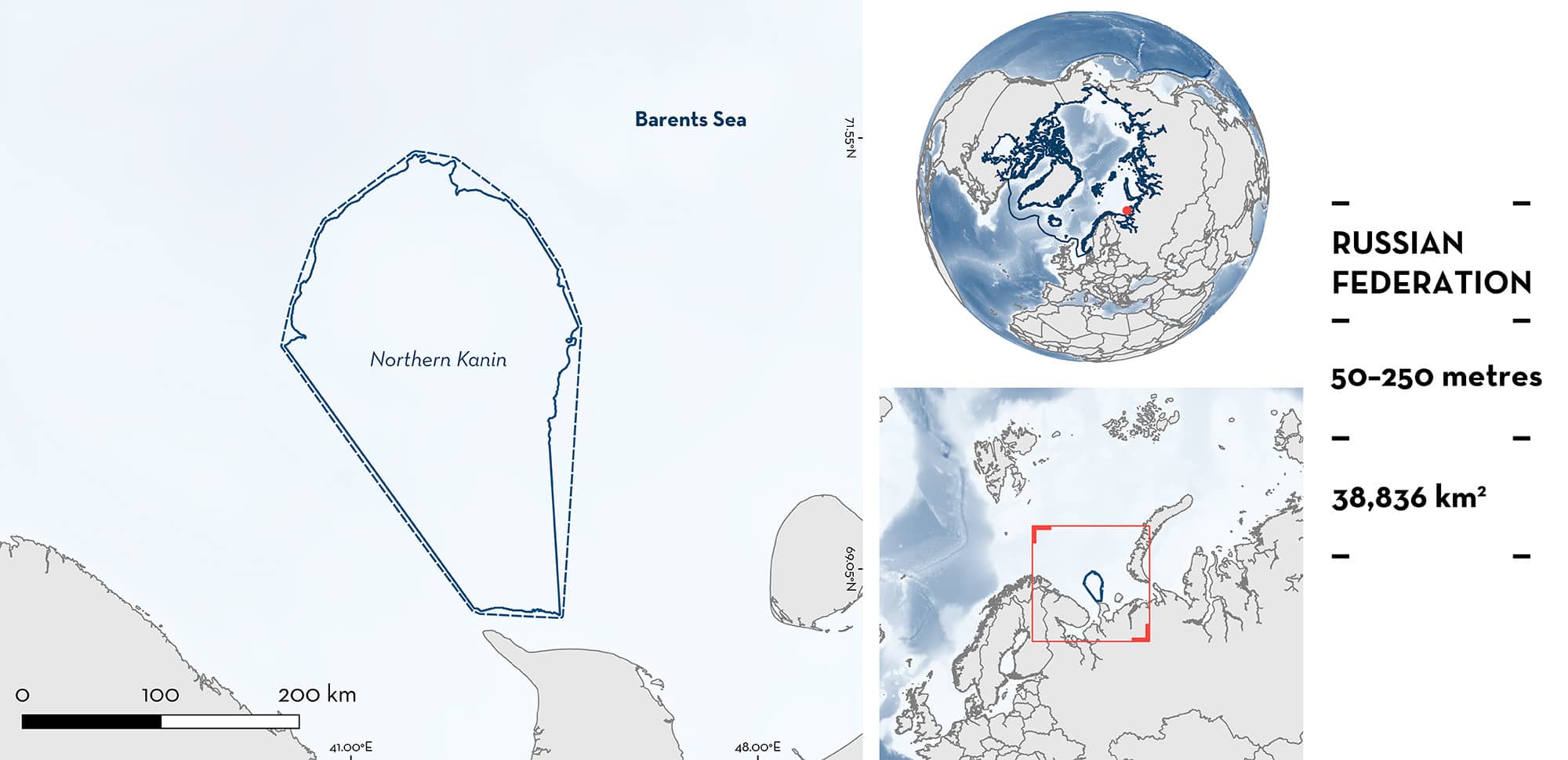ISRA FACTSHEETS
ISRA FACTSHEETS
POLAR WATERS REGION
Northern Kanin
Summary
Northern Kanin is located in the southeastern Barents Sea within the exclusive economic zone of the Russian Federation. The area is characterised by an extended shelf with shallow banks. It overlaps with the South-eastern Barents Sea (the Pechora Sea) Ecologically or Biologically Significant Marine Area. Within the area there are: threatened species and undefined aggregations (Thorny Skate Amblyraja radiata).
Download factsheet
Northern Kanin
DESCRIPTION OF HABITAT
Northern Kanin is located in the southeastern Barents Sea and sits adjacent to the Nenets Autonomous Okrug in the Russian Federation. The area is characterised by an extended shelf with shallow banks.
The oceanography of the area is moderated by the inputs of warm Atlantic waters and cold, nutrient-rich Arctic waters that give rise to the Polar Front in the central Barents Sea (Eriksen et al. 2018). Productivity in the area is related to changes in ice cover, vertical mixing induced by wind, and the influence of both water masses (Reigstad et al. 2002). It is weaker (during boreal spring and summer blooms) than in the northern part of the Barents Sea. However, due to deeper mixing there is a constant supply of nutrients to upper layers creating a high productivity area (Reigstad et al. 2002).
The area overlaps with the South-eastern Barents Sea (the Pechora Sea) Ecologically or Biologically Significant Marine Area (EBSA; CBD 2024). In addition, the area overlaps with areas closed to trawl fishing (Ministry of Agriculture of the Russian Federation 2023).
This Important Shark and Ray Area is benthic and subsurface and is delineated from 50 m to 250 m based on the depth range of Qualifying Species in the area.
CRITERION A
VULNERABILITY
One Qualifying Species considered threatened with extinction according to the IUCN Red List of Threatened Species regularly occurs in the area. This is the Vulnerable Thorny Skate (Kulka et al. 2020).
CRITERION C
SUB-CRITERION C5 – UNDEFINED AGGREGATIONS
Northern Kanin is an important area for undefined aggregations of one ray species.
Skates are known to aggregate, with temporal changes related to sex and life-stage segregations (Swain & Benoît 2006; Frisk 2010; Hoff 2016). The presence of these aggregations is usually related to high density areas where large catch quantities of these species occur (Bizzarro et al. 2014). Scientific surveys in the Barents Sea during the boreal summer-autumn using benthic trawls between 2004–2021 showed that aggregations of the Thorny Skate regularly occur in Northern Kanin (Dolgov & Prozorkevich 2022). Relative abundance (individuals/nautical mile2 [NM2]) was calculated as the area of a trawl haul by multiplying the trawl horizontal opening and hauling distance (Dolgov & Prozorkevich 2022). Standard demersal trawls had a vertical opening of 4–5 m and a horizontal opening of 15–16 m with a tow duration of 15–30 minutes (Dolgov & Prozorkevich 2022).
For Thorny Skate, this area held the highest abundance (mean: 29–74 individuals/NM2; max: 101 individuals/NM2) in all the Barents Sea (Dolgov & Prozorkevich 2022). Individuals of this species were caught in other areas of the region but in lower numbers compared to Northern Kanin where it was mostly found during summer-autumn (period of the joint Russian-Norwegian surveys) at depths between 50–250 m, with multiple individuals caught in a single haul (Dolgov 2016; Eriksen et al. 2021; Dolgov & Prozorkevich 2022). This was also one of the areas with higher abundance of Thorny Skates in autumn-winter between 1996–2001 (Dolgov et al. 2005). More information is needed to confirm the nature of these aggregations.
Download factsheet
SUBMIT A REQUEST
ISRA SPATIAL LAYER REQUEST
To make a request to download the ISRA Layer in either a GIS compatible Shapefile (.shp) or Google Earth compatible Keyhole Markup Language Zipped file (.kmz) please complete the following form. We will review your request and send the download details to you. We will endeavor to send you the requested files as soon as we can. However, please note that this is not an automated process, and before requests are responded to, they undergo internal review and authorization. As such, requests normally take 5–10 working days to process.
Should you have questions about the data or process, please do not hesitate to contact us.


